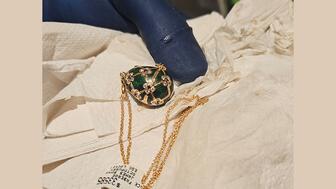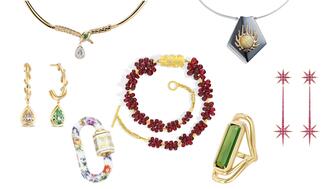Creative Connecting: How to Handle Disclosures
Duvall O’Steen and Jen Cullen Williams share tips on handling some of the not-so-fun, but necessary, aspects of selling fine jewelry.

But many industry professionals struggle with how best to handle them. So, we talked to industry experts to get some top-notch guidance.
Please note that nothing here should be interpreted as legal advice. Rather, these are practical tips to help you communicate necessary information to your customers in person, online or on social media.
What Must Be Disclosed
Let’s start with the basics by looking at what must be disclosed.
According to Miya Owens, Esq., associate counsel of the Jewelers Vigilance Committee, the Federal Trade Commission guidelines make it legally necessary to disclose treatments of gemstones and laboratory-grown diamonds and/or gems.
“Whether communicated verbally or in writing,” says Owens, “sellers must disclose a treatment to a gemstone if that treatment either significantly affects the value of the gemstone (e.g., fractured-filled diamond) or is not permanent (e.g., certain dying of gemstones), or creates special care requirements (e.g., avoid supersonic cleaning).”
Owens further warns that only one of these factors must be at play to trigger the disclosure requirement. Some situations involve all three.
“For example, a diamond that is coated to appear a fancy color meets all three requirements, as that treatment significantly affects the value, is likely unstable and requires special care. The seller should also disclose special care requirements for treated gemstones, where appropriate.”
Sellers can consult the American Gem Trade Association Gemstone Information Manual for guidance regarding whether or not a treatment needs to be disclosed and to better understand the special care requirements that need to be relayed to the customer.
Lab-grown diamonds and gemstones must also be disclosed prior to the sale and in all forms of advertising.
According to Owens, “The FTC recommends the following descriptors for these products, ‘laboratory-grown,’ ‘laboratory-created,’ and ‘[manufacturer name]-created,’ all of which should be used contiguous with the word ‘diamond’ to avoid confusing or deceiving consumers.”
Further, Owens says that the FTC limits the type of language that can be used in disclosure statements. The guidelines also prohibit the use of certain words for laboratory-grown products, including “real,” “natural,” “genuine,” and “precious.”
Make sure everyone on your team knows the law and is familiar with what language can be used. As the saying goes, “Ignorance of the law is no excuse.”
In Person
Now let’s look at specific tips for sharing legally required information with a customer in person during a selling situation.
According to Debbie Azar, president and CEO of Gemological Science International, “In-person disclosures have the advantage of a human-to-human interaction where you can gauge any concerns your client may have and engage in an organic conversation to address any questions.
“Treatments, enhancements, synthetics, and laboratory-grown stones are not ‘bad,’ and it is often the salesperson’s or customer’s perception that they are, which translates into a ‘not-so-fun’ conversation.”
She recommends keeping it positive.
“Thanks to treated or enhanced gemstones, simulants and synthetics, gemstones and jewelry can be accessible at any price point. As long as it is clear what care and maintenance the piece requires (no ultrasonic cleaning, no harsh chemicals, no high heat, avoiding heavy work with hands for rings that may require a little TLC), your customer can rest assured that they know how to look after their piece, and you can avoid any dissatisfaction later.”
Azar also recommends using the conversation to strengthen your relationship with the customer.
“Set expectations. Let your customer know that the rhodium-plated ring may need re-plating at some point. Let them know how long the plating should last with regular wear. Tell them your store is there for them when the time comes. It is the unexpected that generally makes customers unhappy,” she says.
“Also, use the conversation to open the opportunity to see your customers again for regular care and cleaning or checkups on their jewelry. In fact, this type of dialogue actually helps establish a regular relationship. In this way, disclosures are not only a requirement, but a benefit—they immediately build trust.”
The JVC’s Owens recommends making sure tags and signage at point-of-sale also include the necessary disclosures.
“For treated gemstones, I recommend sales associates ensure that any tags or printed items describing the gemstones as treated and noting the specific treatment are visible at all times to consumers. If a consumer asks why the stone is treated, the associates should be prepared with an honest answer, explaining the benefits of treated stones for certain budgets and the fact that certain (not all) treatments are common or necessary to make stones more attractive while maintaining affordability,” she says.
“The treatment and special care requirements should also be in every printed description of the item, including the receipt, any appraisal, report, warranty, etc., but remember—treatments must be disclosed prior to purchase! The same logic applies to laboratory-grown diamonds, cultured pearls, rhodium-plated white gold and other plated jewelry and so on.”
Remember that the guidelines also relate to verbal communication, such as telephone calls.
Owens says: “I have handled several mediations where incorrect descriptions were verbalized by customer service associates to consumers looking to purchase or clarify the details of a purchased good. For example, a customer calls Brand X to ask if an item has a laboratory-grown diamond and the associate says ‘yes,’ although the item actually has a cubic zirconia or other imitation diamond.”
Melissa Becker, vice president of sales and marketing at Berkley Asset Protection, says in-person disclosures also provide an opportunity for the sales associate to become the expert in the selling situation, ultimately building trust with the customer.
“From the insurance side of the business, customers will often ask their jeweler about insuring their jewelry purchase. This creates a chance to offer a value-added service by providing information about jewelry insurance at the point of sale,” she notes. “The jeweler, however, needs to clearly communicate that the insurance information is provided by the insurance company so it does not imply that the jeweler is an insurance broker.”
Azar reiterates that conversations about gemstone treatments don’t have to be negative, noting that many treatments are common and have been used for centuries.
“You can share that the oldest and most common treatment for sapphires is heat to enhance their blue color, and it is commonly accepted. If you want to add a layer of gem-nerdiness, tell the customer that you can sometimes tell a sapphire has been heated by its inclusions, and what gemologists look for, such as dissolved rutile needles and melted crystals. If you really want to impress your customer, talk about the cause of color in sapphires—the intervalence charge transfer and Fe2+ and Ti4+ ions.”
Azar also recommends sharing your personal experience or story about a treated or enhanced gemstone or lab-grown diamonds.
“She may have to get it refilled at some point, and she’s fine with that.”
Online
For e-commerce, disclosures must take place before checkout in a clear, conspicuous, and visible manner.
“If you have fracture-filled or laboratory-grown diamond in the title of a product, great—this is the ideal disclosure,” says Owens.
“In the case of a laboratory-grown diamond,” says Owens, “if you title the item ‘diamond’ and place ‘laboratory-grown’ in the details under a checkout button, you will run afoul of the FTC Jewelry Guides.
“The FTC has specifically stated that ‘laboratory-grown’ or another acceptable descriptor should be used in close proximity to the word ‘diamond’ in the descriptions of relevant products.”
Azar agrees.
“Factors such as physical proximity and placement, prominence, distractions, repetition, and understandable language become the important considerations for online disclosures,” she says.
Here again, she suggests making it a positive.
“Online disclosure for e-commerce does not have the advantage of face-to-face interaction, but it does offer consumers the option to purchase jewelry and gemstones without the constraints of time or distance. This is where being informative can make you stand out. Provide as much information as possible in understandable language. Use third-party resources and articles if needed. When in doubt, check out the FTC’s Dot Com Disclosures.”
Owens and JVC also recommend transparency with metal type.
“If you title a product ‘gold,’ and it is actually gold-plated, you will run afoul of the Jewelry Guides. If you call a hollow product ‘solid,’ you will run afoul of the Jewelry Guides.”
Azar recommends using lab reports with e-commerce for full transparency, while Becker suggests checking with professionals before adding any jewelry insurance information on your website.
“If the jeweler is interested in offering this type of value-add on their site, they should ask their insurance company to provide the content. Jewelers should not write this copy/text as they are not an insurance company or agent,” Becker says.
Owens sums it up best.
“Put simply, honesty is the best policy and always disclose prior to the checkout button in clear and conspicuous text. Pro tip: Check to see how your disclosures display on various devices—computers, tablets and cell phones, as well as various browsers (Safari, Google Chrome, Mozilla Firefox, etc.), to ensure universal visibility.”
Social Media
Many of the above online tips obviously apply for social media as well. But social media adds an additional layer of complexity when working with influencers.
Owens says even if you are not selling directly on a social media platform, the disclosure rules apply because social media is an advertising vehicle.
First, ensure all product descriptions used on your social media outlets, whether in temporary stories or in permanent posts, clearly and properly identify the stones, especially any lab- created diamonds or gemstones.
Avoid using the unacceptable phrases noted above (real, natural, genuine, precious) when referring to lab-grown diamonds or diamond simulants.
Use disclosure language in your brief product captions where possible and always link to the specific product page on your website where a full description, with full disclosures, can be read and reviewed.
If your jewelry is referred to on Instagram, Facebook or Twitter as “diamond” without clearly denoting it as laboratory-created, you can get into legal trouble for failing to comply with the FTC guidelines.
“The FTC warned several brands about this exact issue in 2019,” says Owens. “You can view a sample warning letter here. In this letter, the FTC also cautions sellers of simulated or imitation stones against non-disclosure of the nature of those products.”
More guidance on working with influencers can be found in the FTC Endorsement Guides.
Owens advises brands get influencers to make disclosures too.
“Not only should brands be making the appropriate disclosures, social media influencers should be contractually obligated to make these disclosures as well; influencers should also be disclosing relationships with brands under the FTC’s social media requirements.”
Becker adds that the same philosophy applies for insurance language in social media posts, noting that the jeweler should ask their insurance company for approved content before posting.
The rules of jewelry disclosures are basically the same for all advertising mediums, including in person, online and social media.
Use the tips above to communicate the necessary information clearly and conspicuously as a benefit for your customer.
The more informed their decision, the better they will feel about the purchase. The goal is to avoid deception and to empower the customer with your expertise.
Keep it positive. Keep it clear. And maybe the not-so-fun stuff will turn out to be what closes the sale.
The Latest

The couple pleaded guilty to concealing at least $127 million in cash transactions at its precious metals businesses.

Consumers shared concerns about prices, inflation, tariffs, trade, and politics in the survey’s write-in response section.

In February 2026, the auction house will move its headquarters to the former Steinway Hall, a neoclassical landmark on Billionaires’ Row.

How Jewelers of America’s 20 Under 40 are leading to ensure a brighter future for the jewelry industry.

The new show will take place Jan. 23-25, 2026.


The former BHP Billiton leader and Gemfields chairman is remembered for his influential leadership throughout his 50-year mining career.

The LVMH-owned brand has partnered with the costume design union to revamp its award for 2026.

Roseco’s 704-page catalog showcases new lab-grown diamonds, findings, tools & more—available in print or interactive digital editions.

The luxury titan inked a deal to acquire an initial minority stake in the jewelry manufacturer with a pathway to full ownership by 2032.

The company’s curation of unsigned vintage and estate jewelry debuted at the Bloomingdale’s in Costa Mesa, California.

In the recent multi-shipment seizure, CBP also found counterfeit Audemars Piguet, Moncler, and Chrome Hearts items.

Helzberg’s Chief Retail Officer Mitch Maggart shared details about its tests of a new store concept rooted in an elevated luxury experience.

Jewelers of America execs and National Jeweler editors discuss tariffs, the sky-high gold price, and the engagement that broke the internet.

The luxury goods company said founder Ippolita Rostagno will remain at the brand’s helm.

Laura Burdese, who joined the Italian luxury brand in 2022, will take on the role in July.

The National Jeweler editors revisit the most noteworthy industry happenings and design trends from 2025.

Need a gift for the cat lover who has everything? Look no further than our latest Piece of the Week.

It purchased the “Grosse Pièce,” an ultra-complicated Audemars Piguet pocket watch from the ‘20s, for a record-breaking price at Sotheby’s.

The lab-grown diamond grower now offers custom engagement and fashion jewelry through its Kira Custom Lab Jewelry service.

Chandler got his start at Michelson Jewelers and has served as DCA president and CEO since 2001. He will retire at the end of the month.

The boutique is slated to open this week inside Terminal 8, offering pre-owned Rolex watches and more to international travelers.

Sponsored by Digital Monitoring Products

The special-edition egg pendant ingested in a New Zealand jewelry store was recovered after a six-day wait.

Associate Editor Natalie Francisco plays favorites with Piece of the Week, selecting a standout piece of jewelry from each month of 2025.

The “Love and Desire” campaign is inspired by the magic that follows when one’s heart leads the way, said the brand.

Two awardees will receive free tuition for an educational course at the Swiss lab, with flights and lodging included.

Berta de Pablos-Barbier will replace Alexander Lacik at the start of January, two months earlier than expected.




























